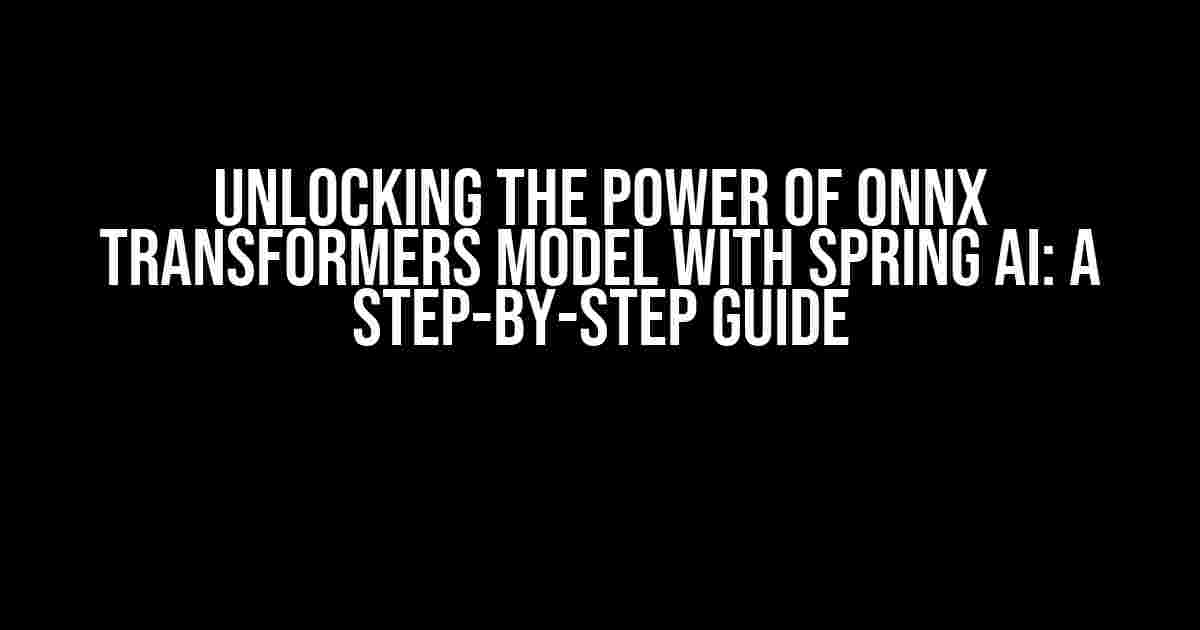In the realm of artificial intelligence, transformers have revolutionized the field of natural language processing (NLP). The ONNX transformers model, in particular, has gained popularity due to its flexibility and ease of deployment. But, have you ever wondered how to use this powerful model with Spring AI? Look no further! In this comprehensive guide, we’ll take you on a journey to unlock the full potential of ONNX transformers model with Spring AI.
What is ONNX Transformers Model?
Before we dive into the integration process, let’s briefly discuss what the ONNX transformers model is. ONNX (Open Neural Network Exchange) is an open format used to represent machine learning models. The transformers model, specifically, is a type of neural network architecture introduced in the paper “Attention is All You Need” by Vaswani et al. in 2017. It’s primarily used for sequence-to-sequence tasks like language translation, text generation, and question-answering.
Benefits of Using ONNX Transformers Model with Spring AI
So, why should you use the ONNX transformers model with Spring AI? Here are some compelling reasons:
- Flexibility**: ONNX models can be deployed on a wide range of devices and platforms, including Windows, Linux, and mobile devices.
- Efficiency**: The transformers model is highly optimized for performance, making it suitable for real-time applications.
- Scalability**: Spring AI provides a robust framework for building scalable AI applications, making it an ideal choice for large-scale projects.
- Simplified Development**: With Spring AI, you can focus on building your application without worrying about the underlying complexities of the model.
Prerequisites
Before you begin, make sure you have the following installed on your system:
- Java 8 or higher
- Spring Boot 2.3 or higher
- ONNX Runtime 1.8 or higher
- Maven or Gradle
Step 1: Setting Up the Project
Let’s create a new Spring Boot project using Maven:
<dependency> <groupId>org.springframework.boot</groupId> <artifactId>spring-boot-starter-web</artifactId> </dependency> <dependency> <groupId>com.microsoft.onnxruntime</groupId> <artifactId>onnxruntime</artifactId> <version>1.8.0</version> </dependency>
Create a new directory for your project and navigate to it in your terminal or command prompt. Run the following command to generate a new Spring Boot project:
mvn archetype:generate -DgroupId=com.example -DartifactId=onnx-transformers-spring-ai -DarchetypeArtifactId=maven-archetype-quickstart
Step 2: Loading the ONNX Transformers Model
Next, we’ll load the pre-trained ONNX transformers model using the ONNX Runtime:
import com.microsoft.onnxruntime.OnnxRuntime;
import com.microsoft.onnxruntime.OrtEnvironment;
@Service
public class TransformersService {
private OrtEnvironment ortEnvironment;
private OnnxRuntime onnxRuntime;
@PostConstruct
public void init() {
ortEnvironment = OrtEnvironment.getEnvironment();
onnxRuntime = ortEnvironment.createInferenceSession("transformers_model.onnx");
}
}
In the above code, we’re creating an instance of the `OrtEnvironment` class, which provides a way to interact with the ONNX Runtime. We then create an instance of the `OnnxRuntime` class, passing the path to our pre-trained ONNX model as an argument.
Step 3: Creating an Inference API
Now that we have the model loaded, let’s create an API to perform inference:
@RestController
@RequestMapping("/api/transformers")
public class TransformersController {
@Autowired
private TransformersService transformersService;
@PostMapping("/infer")
public String infer(@RequestBody String inputText) {
// Pre-processing
String processedInput = preprocessInput(inputText);
// Create input tensor
Tensor inputTensor = transformersService.getInputTensor(processedInput);
// Run inference
Tensor outputTensor = transformersService.runInference(inputTensor);
// Post-processing
String outputText = postProcessOutput(outputTensor);
return outputText;
}
}
In this example, we’re creating a REST API with a single endpoint `/infer` that accepts a string input. We’re then pre-processing the input, creating an input tensor, running the inference using the `onnxRuntime`, and post-processing the output.
Step 4: Integrating with Spring AI
To integrate our ONNX transformers model with Spring AI, we’ll create a new configuration class:
@Configuration
public class TransformersConfig {
@Bean
public TransformersService transformersService() {
return new TransformersService();
}
}
This configuration class creates a bean for our `TransformersService` class, making it available for injection in our application.
Putting it all Together
Now that we’ve completed the integration process, let’s test our application:
@SpringBootApplication
public class OnnxTransformersSpringAiApplication {
public static void main(String[] args) {
SpringApplication.run(OnnxTransformersSpringAiApplication.class, args);
}
}
Run the application using the following command:
mvn spring-boot:run
Use a tool like Postman or cURL to send a POST request to the `/api/transformers/infer` endpoint with a sample input string. You should receive the output of the transformers model in response.
Conclusion
In this comprehensive guide, we’ve demonstrated how to use the ONNX transformers model with Spring AI. By following these steps, you can unlock the full potential of transformers models in your Spring-based applications. Remember to experiment with different models, fine-tune hyperparameters, and explore the vast possibilities of AI with Spring AI.
| Keyword | Description |
|---|---|
| ONNX | Open Neural Network Exchange format |
| Transformers Model | A type of neural network architecture for sequence-to-sequence tasks |
| Spring AI | A Spring-based framework for building AI applications |
We hope this article has been informative and helpful. Happy coding!
Frequently Asked Question
Get started with ONNX Transformers model and Spring AI with these frequently asked questions!
What is ONNX and how does it relate to Spring AI?
ONNX (Open Neural Network Exchange) is an open format for machine learning models, allowing developers to easily convert and use their models across different frameworks and platforms. With Spring AI, you can leverage ONNX to deploy and manage your machine learning models, including Transformers models, in a scalable and efficient way.
How do I deploy an ONNX Transformers model with Spring AI?
To deploy an ONNX Transformers model with Spring AI, you’ll need to follow these steps: convert your model to ONNX format, upload it to Spring AI, and then create a deployment configuration. Once deployed, you can use the model for inference and integrate it with your application using Spring AI’s APIs and client libraries.
What kind of Transformers models can I use with Spring AI?
Spring AI supports a wide range of Transformers models, including BERT, RoBERTa, XLNet, and more. You can use pre-trained models from popular libraries like Hugging Face’s Transformers, or train your own custom models and convert them to ONNX format for deployment with Spring AI.
How do I optimize my ONNX Transformers model for deployment with Spring AI?
To optimize your ONNX Transformers model for deployment with Spring AI, consider techniques such as model pruning, quantization, and knowledge distillation to reduce model size and improve inference performance. You can also use Spring AI’s built-in model optimization features to further optimize your model for deployment.
Can I use Spring AI’s APIs to integrate my ONNX Transformers model with my application?
Yes, Spring AI provides a range of APIs and client libraries that allow you to easily integrate your ONNX Transformers model with your application. You can use these APIs to send requests to your deployed model, retrieve predictions, and integrate the model with your application logic.



